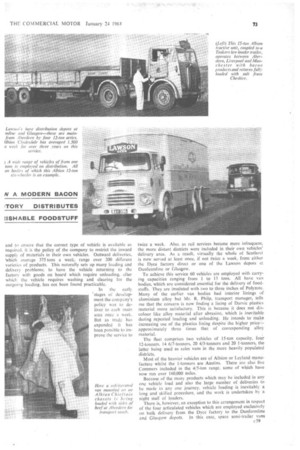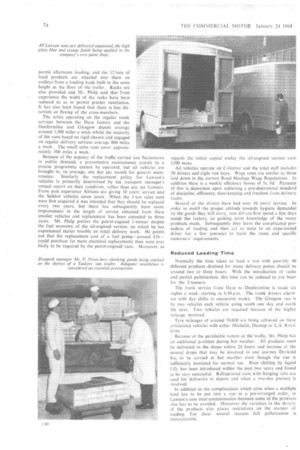This Little Pig Went to— Byte
Page 74

Page 75

Page 76

If you've noticed an error in this article please click here to report it so we can fix it.
By S. Buckley
ASSOC. INST. T.
QUALITY is obviously of prime importance where foodstuffs are concerned. Hygienic conditions of manufacture are imperative. It is equally important that foodstuffs should be handed to customers in the same condition as they left the factory. Where perishable products such as bacon, pork, sausages and pies are concerned, the time factor is vital in any delivery service.
This is the distribution problem which faces many food manufacturers.. In the bacon trade a high degree of competition further complicates the problem. Moreover changes in public demand for the large variety of products nianufactured can cause wide fluctuations in the distribution pattern. Briefly, these are the underlying conditions which have to be met by the delivery service provided by the C-licence fleet operated by Robert Lawson and Sons (Dyce) Ltd. from their headquarters and modern factory at Dyce, Aberdeen, and their depots at Dunfermline and Glasgow.
Discussing the reason why they operate their own vehicles rather than hand the whole of their traffic to professional operators, Mr. R. P. Wilkie, sales director, agrees that hauliers cover all the areas to which they are at present delivering. It is, however, imperative with the type of product carried that there should' be a continuity of both delivery and driver. Because of the highly perishable nature of the products and the attention to hygiene which is essential at all times, special types of vehicle and highly trained staff are the key to an efficient delivery service_ Moreover, due to the regularity of routes, their drivers are able to assess customer requirements
and obtain many repeat orders. .
In their delivery service, all parts of Scotland are served in 48 hours from the time the product is manufactured, whilst 80 per cent of their traffic is delivered within 24 hours. Because Lawson's products are chilled, not frozen, are sold to the ,publie shortly after delivery to the retailer and are eaten soon afterwards, a regular and fast service is essential.
Weekly intake to the Dyce factory includes approximately 6,000 pigs and—as a comparatively new venture-350 cattle and 600 sheep. It is planned shortly to increase this new intake to 600 cattle and 1.000 'sheep weekly. Along with other basic materials the bulk of this intake is delivered into Dyce by the appropriate suppliers, return loading on company's 'vehicles being limited to approximately 40 tons a week.
To maintain a high standard of delivery service and to ensure that the correct type of vehicle is available as required. it is the policy of the company to restrict the inward supply of materials in their own vehicles. Outward deliveries, Which average 375 tons a week, range over 200 different varieties of products. This naturally sets up many loading and delivery problems; to have the vehicle returning to the factory with goods on board which require unloading, after which the vehicle requires washing and clearing for the outgoing loading, has not been found practicable.
In the early 'stages of development the company's policy was to deliver to each main area once a week. But as trade has expanded it has been possible to improve the service to twice a week. Also, as rail services became more infrequent, the more distant districts were included in their own vehicles' delivery area. As a result, virtually the whole of Scotland is now served at least once, if not twice a week, from either he Dyce factory direct or one of the Lawson depots at Dunfermline or Glasgow.
To achieve this service 60 vehicles are employed with carry ing capacities ranging from 1 to 15 tons. All have van bodies, which are considered essential for the delivery of foodstuffs. They are insulated with two to three inches of Polyzote. Many of the earlier van bodies had interior linings of aluminium alloy but Mr. R. Philp, transport manager, tells me that the concern is now finding a lining of Darvic plastics material more satisfactory. This is because it does not discolour like alloy material after abrasion, which is inevitable during repeated loading and unloading, fie intends to make increasing use of the plastics lining despite the higher price— approximately three times that of corresponding alloy material.
The fleet comprises two vehicles of I5-ton capacity, four 12-tonners. 14 6/7-tonners, 20 4/5-tonners and 20 1-tonners, the latter being used as sales vans in the more heavily populated districts.
Most of the heavier vehicles are of Albion or Leyland manufacture whilst the 1-tonners are Austins. There arc also five Commers included in the 4/5-ton range, some of which have now run over 160.000 miles.
Because of the many products which may be included in any one vehicle load and also the large number of deliveries to be made in any one journey, vehicle loading is inevitably a long and skilled procedure, and the work is undertaken by a night staff of loaders. There is, however, an exception to this arrangement in respect of the four articulated vehicles which are employed exclusively on bulk delivery from the Dyce factory to the Dunfermline and Glasgow depots. In this case, spare semi-trailer vans permit afternoon loading, and the 12 tons of food products are wheeled into them on trolleys from a loading bank built to the same height as the floor of the trailer. Racks are also provided and Mr. Philp said that from experience the width of the racks have been reduced so as to permit greater ventilation. It has also been found that there is less distortion or flexing of the cross-members.
The artics operating on the regular trunk services between the Dyce factory and the Dunfermline and Glasgow depots average around 1,500 miles a week whilst the majority of the vans based on rigid chassis and engaged on regular delivery services average 800 miles a week, The small sales vans cover approximately 500 miles a week.
Because of the urgency of the traffic carried and fluctuations in public demand, a preventative maintenance system to a precise programme cannot be operated, but all vehicles are brought in, on average, one day per month for general maintenance. Similarly the replacement policy for Lawson's vehicles is primarily determined by the transport manager's annual report on their condition, rather than any set formula. From past experience Albions are giving 10 years' service and the Seddon vehicles seven years: When the 1-ton sales vans were first acquired it was intended that they should be replaced every two years, but there has subsequently been some improvement in the length of service obtained from these smaller vehicles and replacement has been extended to three years. Mr. Philp prefers the petrol-engined 1-torincr despite the fuel economy of the oil-engined version, on which he has experienced starter trouble on retail delivery work. He points out that the replacement cost of a fuel pump—around .£16— could purchase far more electrical replacements than were ever likely to be required by the petrol-engined vans. Moreover, as • regards the initial capital outlay the oil-engined version cost. £100 more.
All vehicles operate on C-licence and the total staff includes 50 drivers and eight van boys. Wage rates are similar to those laid down in the current Road Haulage Wage Regulations. In addition there is a weekly efficiency bonus of 7s. 6d. Payment of this is dependent upon achieving a pre-determined standard of discipline, efficiency, thne-keeping and freedom from delivery faults.
Several of the drivers have had over 10 years' service. In order to instill the proper attitude towards hygiene demanded by the goods they will carry, new drivers first spend a few days inside the factory, -so gaining some knowledge of the many products made. Subsequently they learn the complicated procedure of loading and then act as mate to an experienced driver for a few journeys to learn the route and specific customers' requirements.
Reduced Loading Time Normally the time taken to load a van with poss:bly 40 different products destined for many delivery points should be around two to three hours. With the introduction of racks and partial palletization, this time can be reduced to one hour for the 2-tonners.
The trunk service from Dyce to Dunfermline is made six nights a week, starting at 6.30 p.m. The trunk drivers alternate with day shifts in successive weeks. The Glasgow run is by two vehicles each vehicle going south one day and north the next. Two vehicles arc required because of the higher mileage involved.
Tyre mileages of around 70,000 are being achieved on these articulated vehicles with either Michelin, Dunlop or U.S. Royal tyres.
Because of the perishable nature of the traffic, Nil r. Philp has an additional problem during hot weather. All products must be delivered to the shops within 24 hours and because of the. several drops that may be involved in one journey Dri-kold has to be carried in hot weather even though the van is sufficiently insulated for normal use. Blast chilling by liquid CO, has been introduced within the past two years and found to be very successful. Refrigerated vans with hanging rails arc ased for deliveries to depots and when a two-day journey is nvolved.
In addition to the complications which arise when a multiple load has to be put into a van in a pre-arranged order, in Lawson's case inter-contamination between some of the products also has to be avoided. Moreover the variation in the density of the products also places restrictions on the manner of loading. For these several reasons full palletization is impracticaMe.
























































































































